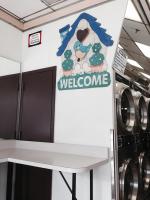GLENDALE, Ariz. — The very first laundromat, then called a “wash-a-teria,” opened in the 1930s during the Great Depression. Back then, people simply couldn’t afford to buy a washer, let alone a dryer, so they’d just wash at the laundromat, then go back home and use a clothesline. And there were no change machines. Customers were basically on their own, using the change in their pockets.
Coin-operated laundromats as we know them didn’t really take off until the 1950s. We’ve come a long way from those beginnings when someone would rent a store and fill it with washers, a handful of dryers, and a few signs saying don’t do this and don’t do that. When I came into the industry in 1976, the vast majority of mats were terrible. They were mostly unattended and the owners were only interested in them as a sideline.
There weren’t enough mats, making the demand for them so lucrative that many owners didn’t care if they lost a customer or two. Therefore, they didn’t have the motivation to respond well to complaints and rarely did they retool or renovate their mats.
Distributors were also less responsive back then, due to the same principle of low competition.
There was little sharing of knowledge for success in the past, and not many places to ask questions. You were left to figure out many problems on your own.
The best source of help back then was industry trade magazines, usually featuring a successful mat in every issue so you could glean some ideas.
Generally, laundromats today are far more sophisticated and professionally run than those small mats of yesteryear.
Somewhere along the way, real entrepreneurs noticed that running a mat isn’t just a hobby or a sideline, it’s a business, and should be treated as such.
Our industry needs shared knowledge in order to progress and improve, and it has, thanks to online forums that have popped up. You can ask a question and often get several replies. You can actually “talk” to other mat owners who achieved success. And you can read about problems that you never would have fathomed were a possibility.
TECHNOLOGY SAVED THE DAY (SORT OF)
The birth of cellphones, surveillance cameras and the internet changed everything. Advertising on Facebook, Google and other places became far cheaper and more dynamic than placing an expensive ad in The Yellow Pages.
Cellphones were a godsend, allowing you to be easily reachable in an emergency. They’ve evolved to enable laundry owners to see on their phone what’s going on in their store through their surveillance system.
Also of note, machine manufacturers embarked on a steady path of improving their equipment with each new series. Washers and dryers became far more functional and sophisticated, albeit more complicated. New equipment designs extract better, and use less energy, water and gas.
You can now collect and analyze data with your computer on the effectiveness of your advertising, usage patterns and promotions. You can see if they are really effective rather than just guessing.
You can even input all your repairs to come up with a predictability model so you can do maintenance more efficiently before things go wrong.
For instance, if you record all your repairs, you can see just how many water valve diaphragms you have replaced for, say, 40 washers over the past year. Each machine can have at least five diaphragms, translating to 200 potential failures.
With this information, you can determine how many more are likely to fail and come up with a plan to either replace them or maybe just change all the valves, which could involve less work for you while lowering the chances of any other valve issues for quite a while.
SO WHAT MORE CAN WE DO?
Maintenance, Maintenance, Maintenance! — Well, improving your own mat improves the industry ever so slightly. If every laundry performed proper maintenance, our industry reputation would grow.
In order to present a satisfactory laundromat to the public, one that is clean, beautiful, and features working equipment throughout, you must do periodic maintenance. You want to stop problems before they come up!
The biggest challenge is simply finding the time, money and effort to do routine maintenance!
Over the years of fielding hundreds, maybe thousands, of newbie questions about equipment problems they are having, the biggest common denominator is lack of maintenance.
Equipment manufacturers all have suggested or required maintenance for their machines, but how many operators actually heed them?
Human nature is to just wait until a problem comes up. However, there are things you should never ignore, such as dryer lint buildup that can cause a serious fire, or lint building up in drains and causing water main backups. Both can bring you a lot of grief.
Read your operator manuals. It’s in your own interest, as well as that of your customers and any neighboring stores.
Take Advantage of Online Resources — Knowledge is not just power, it’s profit. If you go online and say, visit an industry forum, I’m confident you’ll make more money and have fewer headaches and losses.
Even if you’re moderately successful, you can’t think of everything. But you can post any question you want and I guarantee you’ll get an answer. Not sure what kind of floor to install? Ask for input in a forum and you’re likely to get answers along with photos of various flooring that other operators like and the reasons why.
The forums will help you, you’ll help the forums, and, by default, the whole industry advances.
Host a “Free Laundry” Event — Helping your community with such an event—the LaundryCares Foundation is known for them—is a nice trend that improves our industry image. It can gain you free promotion on local TV and YouTube, and local politicians love such events.
Make It Easy for the Customer — Try installing automatic doors, or a walk-up or drive-up window for drop-offs and pickups.
Check back on Thursday for the conclusion
Have a question or comment? E-mail our editor Bruce Beggs at [email protected].











